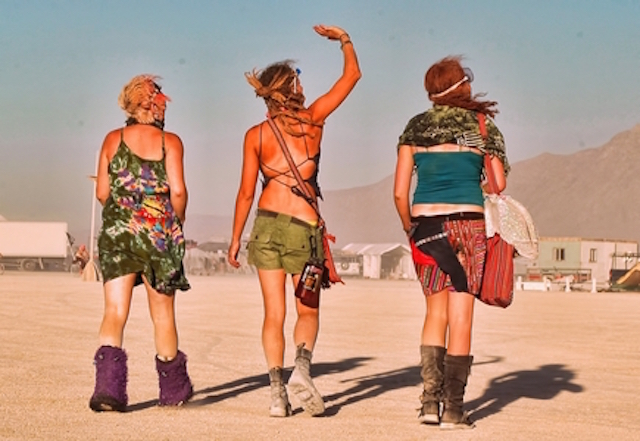
“And that, I think, was the handle—that sense of inevitable victory over the forces of Old and Evil. Not in any mean or military sense; we didn’t need that. Our energy would simply prevail. There was no point in fighting—on our side or theirs. We had all the momentum; we were riding the crest of a high and beautiful wave. . . .
So now, less than five years later, you can go up on a steep hill in Las Vegas and look West, and with the right kind of eyes you can almost see the high-water mark—that place where the wave finally broke and rolled back.”
~ Hunter S. Thompson
Hunter S. Thompson’s words were intended be a prophetic proclamation that the idealism of the 1960s America had failed its believers.
But Hunter Thompson’s often repeated lines could be even more relevant today inside the confines of a similarly desolate desert landscape that provides the promise of a colorful city where adults and their dreams can play, Burning Man. Thompson was originally writing about how Las Vegas and its vices and moral decay symbolized the corruption and end of the American Dream.
Many people who attend the annual Burning Man are now making similar claims about their long, beloved festival. Some are saying that the idealism fueling the festival from earlier years has been corrupted by expansion and corporate participation. I read one online comment that harked, “Ding Dong…The Man Is Dead!” And perhaps their critics are correct.
It’s an idea that I wouldn’t ordinarily entertain—except in an odd moment. The dust from a another Burning Man desert squall this year whipped into a circle of life over the late afternoon din of a dee-jay-led thump-a-rama- dance party alongside a popular festival dance club called Reno Nation. Bodies writhed in the sweat-drenched late afternoon frenzy of the festival’s opening day when I heard it—the faint but distinct, melancholic, tinkling piano notes of, Goodbye to the Yellow Brick Road, Elton John’s ballad critique of material extravagance, trailing from an unseen art car passing in the distance.
“Back to the howling old owl in the woods
Hunting the horny back toad
Oh I’ve finally decided my future lies
Beyond the yellow brick road.” ~ Elton John
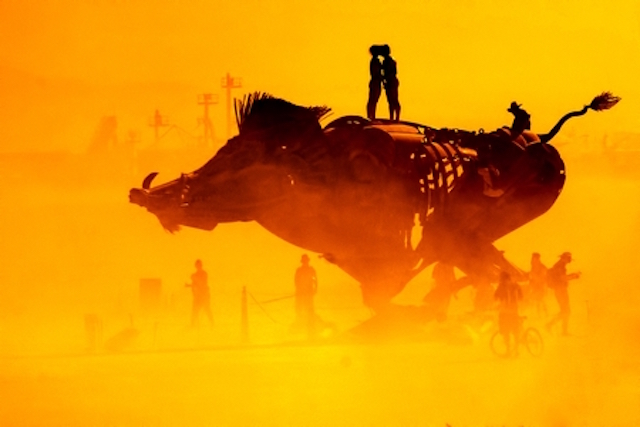
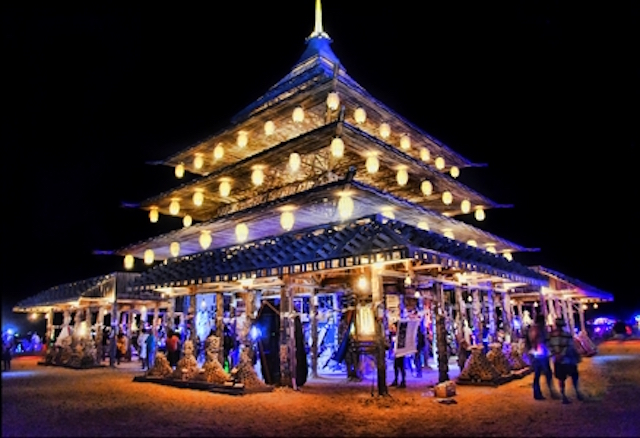
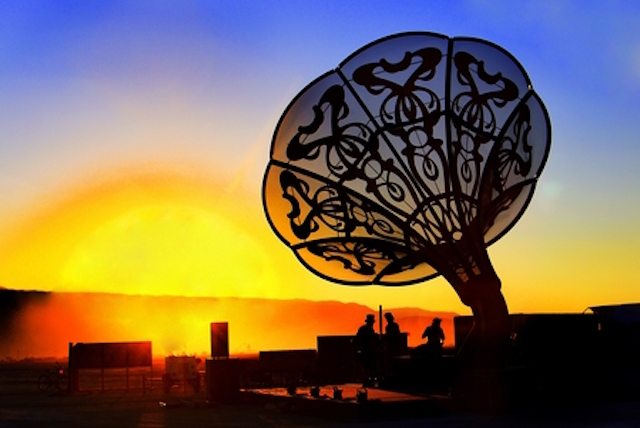

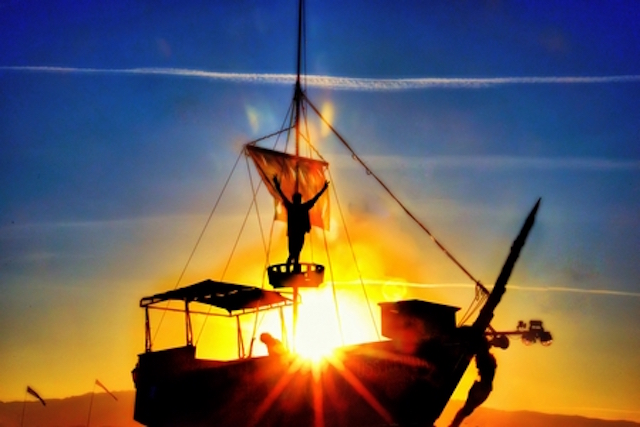
Elton John’s 1973 tune referenced the fabled road leading to The Emerald City in the 1936 film The Wizard of Oz, a place analogous to Burning Man. The tune passed like a whiskey-hoarse whisper to me through the party din, but instantly reminded of a growing louder chorus of people who are claiming that the future of festival life and culture lies beyond the annual confines of Black Rock City.
Certainly, as the Burning Man festival has ballooned from the original 13 or so participants in 1986 to the current population of 70,000, it faces challenges to its long-held reputation as an idyllic, utopian community. Critics decry the increased involvement of corporate money in funding theme camps, dance clubs and art cars. They also point to the appearance in recent years of festival establishments that hire help to build their camps and feed their participants—a move, they say, betrays two of the festival’s stated, main principles, “radical self-reliance” and “de-commodification.”
Also, as the festival has grown, another concern has emerged—major acts of vandalism. This year two significant attacks happened. One so-called “VIP camp” hosting nightly DJ parties called the White Ocean fell victim to an attack that included cut electrical lines that spoiled refrigerated food, vandalized camp infrastructure and a dump of 200 gallons of potable water flooding across camp.
A second, less publicized attack descended on an encampment called the Iron Monkeys, a Seattle-based metalworking collective which has brought art to the playa for 10 years. This year, they built a blacksmith shop, Piazza di Ferro, and spent the week teaching blacksmithing to the citizens of Black Rock City. Vandals caused significant damage to internal and external spaces. Even though many people declare that violent acts against property or people cannot be allowed to continue, others point to the vandalism this year at Burning Man as a sign of its demise.
Burning Man may be suffering from the inevitable pitfalls of growth, and oversized expectations. Truthfully, the bigger the festival, the more problems that arise. Some festival participants say that the stronger potential of transformational/spiritual growth within the festival scene now lies with smaller festivals. They point to the successes of much smaller, newer events like Symbiosis in California and the Arise in Colorado as well as the emergence of smaller regionally-based Burner events. These events, dubbed “transformational festivals” have much to offer and leave many of their participants feeling inspired. And while problems and conflicts happen in those events too, they do not seem to happen as often, and certainly not on the same scale.
But still another faction of people claim that because of advent of defined rules, regulations, law enforcement and intense planning, Burning Man is still a surprisingly safe space in which artistry and self-expression can still thrive. That may be so, and there are many ways to still be inspired by Black Rock City.
The magic of Burning Man isn’t dead, not by a long shot.
Creativity and immense beauty still thrive, but there are a number of pitfalls that could diminish the luster of the festival’s beauty and magic. Vandalism is just one problem that needs to be addressed.
But, perhaps the future of transformational festivals does lie beyond Burning Man. Perhaps it always did. And perhaps that’s the point anyway. 15 years ago, Burning Man was an amazing beginning point for a new way of seeing and living in the world. But that moment was only a beginning of a long and often difficult journey of growth.
Any experience of beauty, magic, or transformation always stays in that particular time or place—if one doesn’t create new spaces and moments of magic, there aren’t any. Burning Man lasts one week per year. Music festivals are even shorter. So, the question really isn’t whether the magic of Burning Man is dead; the question is can festival aficionados, like myself, create a little of our own magic in the other 358 days in a calendar year?
The task is not always easy or as fun as going to an event like Burning Man, but plenty of folks create magic without ever participating in a festival, of any size, at all. Many start humbly, by going within. Many start within the boundaries of their own skins, their own lives and their own homes.
So, if there is no point in fighting—on our side or theirs, how do we create the high watermark of new cultural wave?
Certainly, People have their own path to follow. However, if we walk to the nearest mirror, with the right set of eyes, perhaps we all will able to see the beginning crest of a more beautiful wave. And, I suspect it will crest somewhere beyond the yellow brick road.
~
Author: Andrew Wyatt
Images: courtesy of the author
Editor: Ashleigh Hitchcock


 Share on bsky
Share on bsky




Read 1 comment and reply